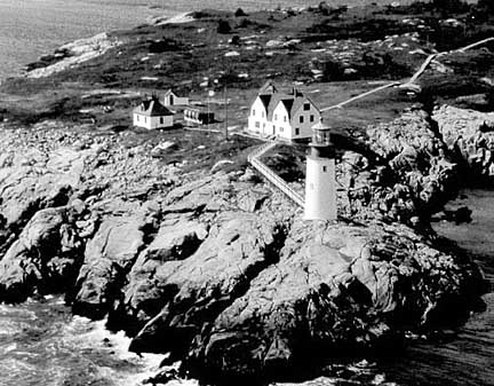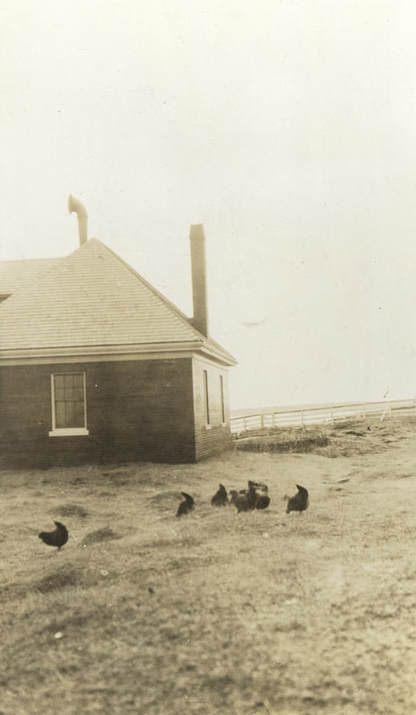History of Moose Peak Light, near Jonesport, Maine
© Jeremy D'Entremont. Do not reproduce any images or text from this website without permission of the author.
More information: Front page / Photos / Bibliography / Cruises / Postcards
The body of water known as Moosabec Reach, off the northern Maine coast about halfway between Bar Harbor and Eastport, separates Jonesport from Beals Island and several smaller islands. The name “Moosabec” is believed to have had its origins in an Abenaki Indian word, possibly meaning “moose head.”
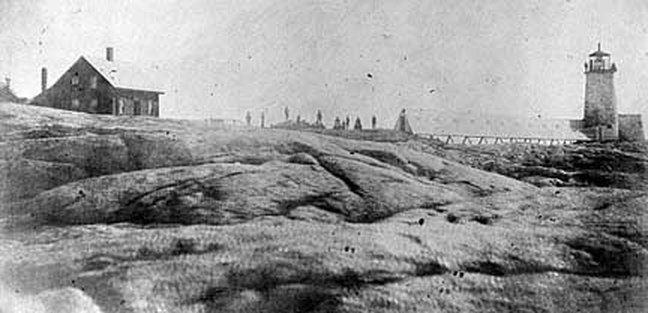
Circa 1859 (National Archives)
Why the name was applied to the reach isn’t clear, but a number of spelling variations have appeared through the years: Mispecky Reach, Moose a Becky’s Reach, Muspecka Rache, Moose Peak Reach, and others. The name of approximately 30-acre Mistake Island, about four miles south of Moosabec Reach at the southwest side of the entrance to the shipping channel known as Main Channel Way, appears to be another corruption of “Mooseabec.” Mistake and several nearby islands were sometimes collectively referred to as the Moose Peak Islands.
Congress and President John Quincy Adams authorized the building of a lighthouse on the east point of Mistake Island, about five miles from Jonesport, in March 1825. Three acres of land were purchased for the station at a cost of $150.
Congress and President John Quincy Adams authorized the building of a lighthouse on the east point of Mistake Island, about five miles from Jonesport, in March 1825. Three acres of land were purchased for the station at a cost of $150.
The light served to guide mariners to Moosabec Reach and Beal’s Harbor to the north, and to guide direct coastal traffic heading east to the Bay of Fundy. The station was established for $3,955.60 in October 1826.
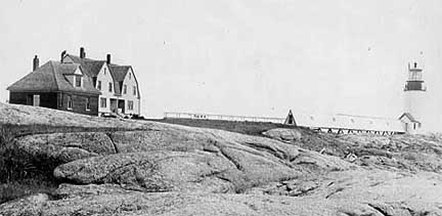
Circa late 1800s (U.S. Coast Guard)
A 24-foot-tall round rubblestone tower was constructed by Jeremiah Berry, and a rubblestone dwelling was built 297 feet from the tower. The lighthouse was topped by a wrought-iron lantern, seven feet high, with a copper dome. A wooden footbridge made it possible to walk across a chasm between the house and the tower.
The first keeper, Alexander Milliken, purchased the remaining 17 acres of Mistake Island for $75. He asked for, and received, a pay raise in 1829 because of the station’s isolation.
Milliken was still in charge at $400 yearly when I. W. P. Lewis examined the station for his report to Congress in 1843. Milliken complained that the house was out of repair; the kitchen wall had cracked away from the main building, the house walls were cracked in several places, and the pointing between the stones had fallen away. Rain and snow entered through the walls of the house in storms.
The first keeper, Alexander Milliken, purchased the remaining 17 acres of Mistake Island for $75. He asked for, and received, a pay raise in 1829 because of the station’s isolation.
Milliken was still in charge at $400 yearly when I. W. P. Lewis examined the station for his report to Congress in 1843. Milliken complained that the house was out of repair; the kitchen wall had cracked away from the main building, the house walls were cracked in several places, and the pointing between the stones had fallen away. Rain and snow entered through the walls of the house in storms.
During a storm in February 1842, the lantern deck of the lighthouse was thrown out of level and the mechanism that turned the lighting apparatus was stopped. In a storm three years earlier, the high seas had washed away the footbridge and nearly destroyed the lighthouse.
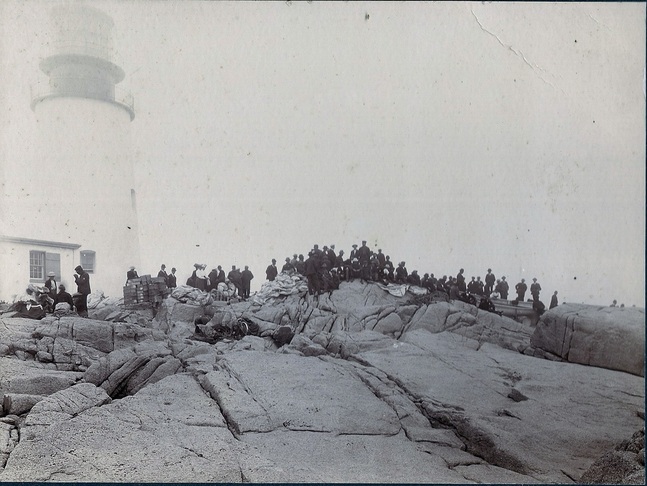
Undated photo of the aftermath of a shipwreck (labeled "Bruster") at Mistake Island. Courtesy of Tom Schultz.
Joshua Walker was appointed keeper, succeeding Milliken, in October 1849. The condition of the station hadn’t improved by the following year, when an inspection report recommended the rebuilding of the tower and dwelling. In 1851, Luther Jewett, superintendent of Maine’s lighthouses, reported that a fissure in the tower had left it leaning to the west. The keeper had spent ten nights in a row, with another person, turning the lighting apparatus by hand.
The records are vague, and some sources claim that the tower was repaired and not rebuilt in 1851. A letter from a contractor named S. Emeson, dated September 20, 1851, seems to confirm that the tower was rebuilt that year. Emeson’s letter was addressed to “Mssrs. Grose & McLaughlin, Moose Peak, Light Builders.” Emeson wrote (original spelling retained):
I send all the lantern & all the belongs to it when you are ready to put it up. . . . Mr. Jewett sais it must be ready to light on the 1 of next month. I am to have the old Lightning Rod for the new tower. . . . I have got now the Best lantern for Moose Peak there is or ever was in this State.
The records are vague, and some sources claim that the tower was repaired and not rebuilt in 1851. A letter from a contractor named S. Emeson, dated September 20, 1851, seems to confirm that the tower was rebuilt that year. Emeson’s letter was addressed to “Mssrs. Grose & McLaughlin, Moose Peak, Light Builders.” Emeson wrote (original spelling retained):
I send all the lantern & all the belongs to it when you are ready to put it up. . . . Mr. Jewett sais it must be ready to light on the 1 of next month. I am to have the old Lightning Rod for the new tower. . . . I have got now the Best lantern for Moose Peak there is or ever was in this State.
Charles R. Dobbins was the keeper from 1887 to 1905. In 1898, after Dobbins and his son rendered “gallant assistance” to the crew of the Nova Scotian schooner Ashton, the keeper was awarded a gold watch by the Canadian government. Dobbins couldn’t accept the gift until he was authorized to do so by an act of Congress.
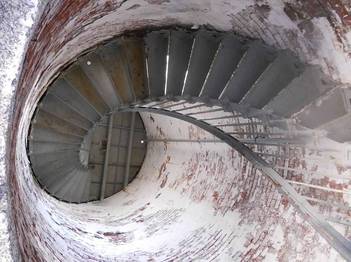
The stairs in the tower (General Services Administration)
By 1901, the keeper's house was in disrepair. Two years later, a new two-family house was completed and linked to the lighthouse tower by a walkway.
For most of its history, the station had a keeper and one assistant, both of whom lived on the island with their families. Life was usually harmonious, but there were times when the island seemed too small. In 1887, the local inspector wrote to the chairman of the Lighthouse Board that the “wife of the Principal Keeper and his grown up daughters” used “the vilest possible language” toward the assistant keeper and his family, visitors, and even toward the principal keeper himself. The principal keeper, Thomas Dodge, was soon removed and the assistant, Charles E. Dobbins, was promoted.
In 1912, a fog signal house was erected with a powerful diaphragm fog horn. The signal had to be sounded for 181 consecutive hours in 1916. During the period from 1918 to 1934, the keepers at Moose Peak Light logged more hours of dense fog than any other Maine light station. The island averaged 1,607 hours per year, meaning it was foggy about 20% of the time.
Albion Faulkingham was keeper for several years in the 1920s. He and his wife, Lucy, had three daughters. Their daughter Florence gave birth to a child, Albion "Tuddy" Kenney, on March 17, 1924, while on a boat headed for the mainland from Mistake Island.
Moose Peak Light was automated in 1972 and the last Coast Guard keepers were removed. The Fresnel lens was replaced by an acrylic optic. The dwelling was almost sold to a private party, but the high cost of a sewage system that would meet Environmental Protection Agency standards caused the sale to fall through.
For most of its history, the station had a keeper and one assistant, both of whom lived on the island with their families. Life was usually harmonious, but there were times when the island seemed too small. In 1887, the local inspector wrote to the chairman of the Lighthouse Board that the “wife of the Principal Keeper and his grown up daughters” used “the vilest possible language” toward the assistant keeper and his family, visitors, and even toward the principal keeper himself. The principal keeper, Thomas Dodge, was soon removed and the assistant, Charles E. Dobbins, was promoted.
In 1912, a fog signal house was erected with a powerful diaphragm fog horn. The signal had to be sounded for 181 consecutive hours in 1916. During the period from 1918 to 1934, the keepers at Moose Peak Light logged more hours of dense fog than any other Maine light station. The island averaged 1,607 hours per year, meaning it was foggy about 20% of the time.
Albion Faulkingham was keeper for several years in the 1920s. He and his wife, Lucy, had three daughters. Their daughter Florence gave birth to a child, Albion "Tuddy" Kenney, on March 17, 1924, while on a boat headed for the mainland from Mistake Island.
Moose Peak Light was automated in 1972 and the last Coast Guard keepers were removed. The Fresnel lens was replaced by an acrylic optic. The dwelling was almost sold to a private party, but the high cost of a sewage system that would meet Environmental Protection Agency standards caused the sale to fall through.
In 1982 a military team blew up the keeper's house as a training exercise. The Maine State Historic Preservation Officer had given his OK, saying that the 1903 house didn't have any particular historic value and it was in poor condition. The demolition didn't go exactly as planned. Stephen Perrin wrote in the Island Journal:
About midnight a Coast Guard cutter carried 21 men . . . out to the vicinity of Mistake Island off Jonesport. Towing 500 pounds of TNT and some composition explosive in a rubber raft, an assault team swam to the landing site around 0500 and 'infiltrated' the vandalized dwelling. The exercise then went into an 'administrative mode' and classes were held in the art of demolition. The charges had been placed so that the walls would implode into the building, but as it turned out the timbers flew outward, breaking panes in the lighthouse lantern and damaging the helicopter pad.
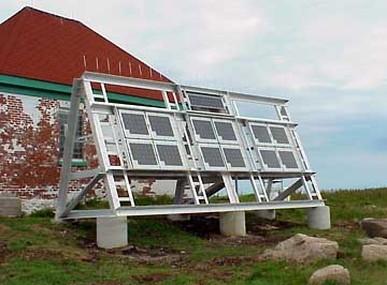
These solar panels were installed in 1999.
U.S. Coast Guard photo
In recent years, a nonprofit group called Keepers of Moose Peak Light worked to gain ownership with the goal of restoring the lighthouse. The lighthouse was offered to a suitable steward in 2010-11 under the guidelines of the National Historic Lighthouse Preservation Act, and an application was submitted by Keepers of Moose Peak Light. The application was not approved, so the lighthouse was auctioned to the general public along with the boathouse and 5.89 acres of land. (The fog signal building remains under Coast Guard ownership.)
The auction ended on October 31, 2012, with a high bid of $93,500. The high bidder was Donald J. Vaccaro of Connecticut. It was later sold to Jeremey Richardson and Miriam Davidson. They are gradually restoring the lighthouse.
GoFundMe page for preservation of Moose Peak Lighthouse
Interview with Jeremey Richardson and Miriam Davidson on the U.S. Lighthouse podcast Light Hearted:
The auction ended on October 31, 2012, with a high bid of $93,500. The high bidder was Donald J. Vaccaro of Connecticut. It was later sold to Jeremey Richardson and Miriam Davidson. They are gradually restoring the lighthouse.
GoFundMe page for preservation of Moose Peak Lighthouse
Interview with Jeremey Richardson and Miriam Davidson on the U.S. Lighthouse podcast Light Hearted:
The remaining 23 acres of Mistake Island, apart from the lighthouse property, is managed by the Nature Conservancy. Moose Peak Light, still an active aid to navigation, can be seen distantly from Great Wass Island. It is best seen by private boat or from the air.
Keepers: (This list is a work in progress. If you have any information on the keepers of this lighthouse, I'd love to hear from you. You can email me at [email protected]. Anyone copying this list onto another web site does so at their own risk, as the list is always subject to updates and corrections.)
Alexander Milliken (1827-1849); Joshua Walker (1849-1851, died in service); Joshua S. Walker (1851-1853); Darius Dickey (1853-1859); William H. Norton (1859-1860); Alexander M. Drisko, assistant (1859-1860); Richard Norton, assistant (1860); Charles B. Murch (1869-1876); Warren Murch, assistant (1869-1873); Charles H. Murch, assistant (1871-?); Veranus Allen, assistant (1876-1880); Samuel Cummings (1876-1881); John W. Guptill, assistant (1882-1883); Augustus F. Carver, assistant (1883-1886); Wilfred S. Lowe, assistant (1886-1887); Nehemiah Guptill (1881-1886); Thomas S. Dodge (1886-1887); Charles R. Dobbins (1887-1905); John L. Norton, assistant (1888-1891); Oscar B. Hall, assistant (1891-1895); James H. Falkingham (Faulkingham?), assistant (1895-1897); Nelson F. Morse, assistant (1897-1901); William A. Atwater, assistant (c. 1905); Herbert Anderson (c. 1910); James Anderson, assistant (c. 1907-?); Eugene Ingalls (1913-1914); Albion Faulkingham (?-c.1925); Joseph Muise (c. 1930s); M. L. Wilson, assistant (c. 1935); Larson O. Alley (Coast Guard, c. 1940s); ENC Paul Joseph Kessler (Coast Guard, 1952); Don Ashby (Coast Guard officer in charge c. 1956-1958); Richard Kelley (Coast Guard, c. 1957); Stanley B. (Red) Crossman Jr. (Coast Guard, 1972-1973)
Keepers: (This list is a work in progress. If you have any information on the keepers of this lighthouse, I'd love to hear from you. You can email me at [email protected]. Anyone copying this list onto another web site does so at their own risk, as the list is always subject to updates and corrections.)
Alexander Milliken (1827-1849); Joshua Walker (1849-1851, died in service); Joshua S. Walker (1851-1853); Darius Dickey (1853-1859); William H. Norton (1859-1860); Alexander M. Drisko, assistant (1859-1860); Richard Norton, assistant (1860); Charles B. Murch (1869-1876); Warren Murch, assistant (1869-1873); Charles H. Murch, assistant (1871-?); Veranus Allen, assistant (1876-1880); Samuel Cummings (1876-1881); John W. Guptill, assistant (1882-1883); Augustus F. Carver, assistant (1883-1886); Wilfred S. Lowe, assistant (1886-1887); Nehemiah Guptill (1881-1886); Thomas S. Dodge (1886-1887); Charles R. Dobbins (1887-1905); John L. Norton, assistant (1888-1891); Oscar B. Hall, assistant (1891-1895); James H. Falkingham (Faulkingham?), assistant (1895-1897); Nelson F. Morse, assistant (1897-1901); William A. Atwater, assistant (c. 1905); Herbert Anderson (c. 1910); James Anderson, assistant (c. 1907-?); Eugene Ingalls (1913-1914); Albion Faulkingham (?-c.1925); Joseph Muise (c. 1930s); M. L. Wilson, assistant (c. 1935); Larson O. Alley (Coast Guard, c. 1940s); ENC Paul Joseph Kessler (Coast Guard, 1952); Don Ashby (Coast Guard officer in charge c. 1956-1958); Richard Kelley (Coast Guard, c. 1957); Stanley B. (Red) Crossman Jr. (Coast Guard, 1972-1973)
